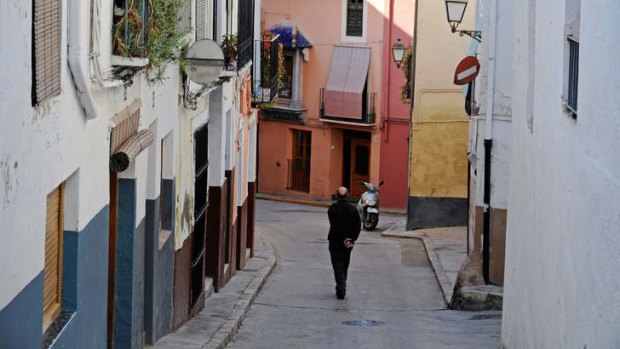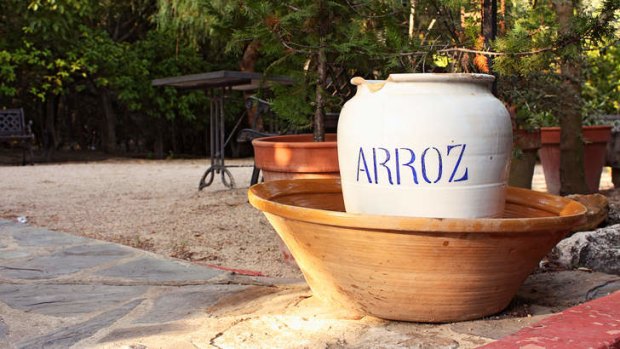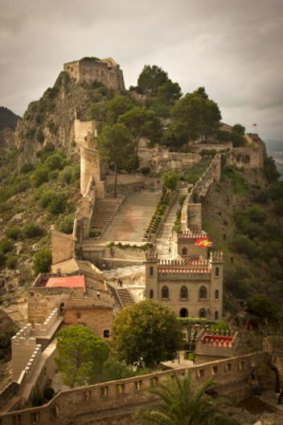
Central Xativa.Credit: Getty Images
Clare Mann explores Xativa in eastern Spain, birthplace of a Borgia pope and a town with a turbulent history.
A beautiful opaque octopus, along with eight types of shrimp, catches my eye first, followed by a revolting barnacle - a percebe, or goose neck barnacle - that looks more like deformed toenails than anything edible. Apparently, this crustacean is prised from the rocks only where the sea foams and crashes, and is considered by many to be the tastiest delicacy in the ocean. At €48 ($60) a kilo, it's also one of the more expensive.
The Mercado Central, the oldest food market in Europe, in the heart of Valencia, is our introduction to The Borgias Tour. More cathedral than market, it is a treat both visual and culinary. Beneath its late 19th-century domes, arches and mosaics is a stunning array of local produce: rows of hanging Serrano hams, mounds of spices, juicy grapes, plump figs, all picked and plucked from the region.

A traditional rice jar.Credit: Alamy
The Borgias Tour is run by Patrick Waller, who has lived in Spain for 20 years with his Spanish wife, Julia. Together they have created several tours - a pleasing mix of history, food, wine and walking in the surrounding country. This one is centred on the mediaeval town of Xativa (pronounced Hat-tiv-a), 45 minutes from Valencia.
Xativa, once the second-most-important city in Spain, grew rich on silk and paper production, using techniques introduced by the Moors, and was also home to the powerful Borja clan, Italianised to Borgia, that produced two Renaissance popes.
David, our guide, takes us on a stroll through the pretty streets of Xativa's old quarter. There is much to see, from the fountain with 25 spouts that brought sparkling water to the city, to the leafy "Kissing Park", so named after star-crossed lovers (forbidden love between a Christian and a Moor is common in Spanish folklore). St Peter's Street is lined with grand old merchants' houses, with coats of arms above ancient doors and set around cool interior courtyards. The handsome house where Pope Alexander VI (Roderic Llancol i de Borja; an ancestor of many of the royal houses of Europe) was born is still a private house, though not all the houses have been so lucky: David points to a dilapidated nobleman's house, which had once been his school; another elegant building opposite is now the police station, though when David was a child it was a medical centre.

The Castle of Xativa.
The future Alexander VI was baptised in St Peter's church, built on the site of a mosque. The priest takes us into the crypt but, disappointingly, all that remains of the skeletons found here are some bone fragments in a bucket.
Philip V burnt the town almost to the ground during the War of the Spanish Succession, and David tells us that the inhabitants of Xativa are still known as the "scorched ones".
We finish our history lesson with a delicious local beer, La Socarrada (scorched), made with lime, honey and rosemary. Describing something as "honey and rosemary", David says, means it's close to perfection - or the bee's knees, if you like.
Above the town perches a magnificent castle, its 30 towers and four fortified gateways stretching along the ridge. In the castle's restaurant we tuck into a classic local dish, arroz al horno - oven-baked rice with pork, black pudding and chickpeas. Rice is grown in the freshwater lagoon of Albufera, close to Valencia.
Later, in the cool of the evening, we visit the chapel of Santa Ana, high on a hill, with views of orange groves and distant mountains.
There's a local story that tells of a young Irishman who collected the key to the chapel from the tourist office in Xativa. When he arrived, he found some old men sitting in the shade, so he produced the key and told them it had been in his family for several centuries. Family legend had it, he claimed, that this was a key to a remote chapel "somewhere in Spain where treasure was hidden" and he had spent some years looking for it. The old men were enthralled - and thrilled when the key fitted. But the chapel was - and is - empty, the only treasure being a beautiful royal-blue ceiling studded with tiny gold stars.
The tour includes a visit with Patrick Waller to Fontanars dels Alforins, the wine-growing region close to Xativa. Here, we visit two small family-run bodegas, where we are warmly welcomed and sample excellent wine. We walk from one bodega to the next, through wild undulating countryside populated by wild boar.
Patrick is a keen ornithologist with a passion for birds of prey, and as we walk he points out European bee-eaters. Sadly, we spot no booted, short-toed Bonellis or golden eagles. We pass the remains of a pre-Roman Ibero settlement along the crest of an escarpment, and abandoned farms, their fig trees heavy with ripe fruit.
Our lunch stop is a highlight of the tour: at the remote and rustic Mas de Monserrat we eat paella cooked by Jose bas Tortosa, an outstanding young chef-patron passionate about authentic Valencian cuisine. While we tuck into tapas, observed by his friendly dogs, Jose cooks the paella on an open fire of vine wood and offers us a delicious local red wine made by a friend. Paella is traditionally eaten straight from the pan, and Jose sets a huge one in the middle of the table, gives everyone a spoon, and we dig in. It's honey and rosemary, as the locals might say.
FAST FACTS
Getting there
Emirates has a fare to Madrid from Sydney and Melbourne for about $1970 low-season return, including tax. Fly to Dubai (about 14hr), then to Madrid (8hr 10min). See emirates.com. This fare allows you to fly back from another European city. Emirates also flies from Sydney-Melbourne to Barcelona. Trains from Madrid to Valencia depart from Atocha train station and take about 90 minutes on the high-speed AVE network. Tickets from €80 ($100). See raileurope.com. Trains and buses operate daily between Valencia and Xativa.
Staying there
Mont Sant, built beneath the castle walls and above the town of Xativa, has peaceful bedrooms set in a lovely, cool and leafy garden of orange trees. Double rooms from €83 a night. See mont-sant.com.
L'Agora Hotel is a restored manor house with eight comfortable bedrooms in the nearby hilltop town of Bocairent. Its restaurant also serves regional specialities. Rooms from €60. See lagorahotel.com.
The small, family-run Hotel El Mudayyan is next to the cathedral of Santa Maria in the mountainous nearby town of Teruel, known for its distinctive Mudejar (Moorish) architecture. Rooms from €60. See elmudayyan.com.
Dining there
Casa Floro in Xativa's Place del Mercat (marketplace) is where the locals go for traditional home cooking.
Mas de Monserrat, Moixent Fontanars, is a farmhouse-restaurant-stay deep in the country among vineyards and sunflowers. Its range of Valencian specialities includes paella and gachas, a meaty stew with hare, rabbit, mushrooms and snails. See www.masmonserrat-moixent.com.
Chef Angel Fita serves "Nouveau Valencian" cuisine and local dishes at Xativa's Canela y Clavo restaurant. Try the crusted cod with manchego and, for dessert, the baked pumpkin and honey. Eat on the terrace or in the cool modern interior. See canelayclavo.com.
Touring there
Patrick Waller's Spanish Thyme Traveller hosts a five-day Borgia Tour (three nights in Xativa; two nights in Bocairent), priced from €1350 a person, twin share. Price includes transport in the area, five nights' accommodation, most meals, an English-speaking tour guide, and entrance fees. See thespanishthymetraveller.com.
When to travel
Avoid the crowds and sleepless nights by steering clear of Valencia in March during the week-long Fallas de San Jose fiesta. Stay outside the city to keep your sanity. Winter months are rarely cold, but can be crisp, while spring and autumn are the most comfortable temperatures.
If you are brave enough to face the August heat, then the Xativa fiesta in the middle of the month is a week-long gastronomic and cultural extravaganza.
Telegraph, London
Sign up for the Traveller Deals newsletter
Get exclusive travel deals delivered straight to your inbox. Sign up now.